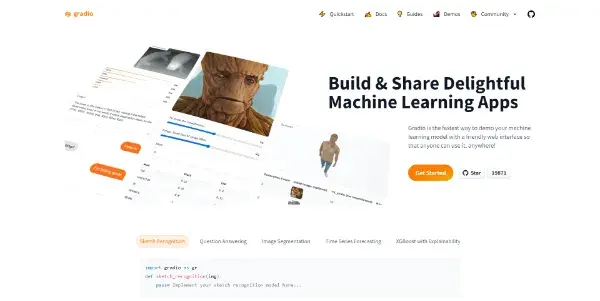Gradio

Create and share machine learning (ML)-based applications with an intuitive, easy-to-understand tool
Gradio: Democratizing Machine Learning Application Deployment
What is Gradio?
Gradio is a powerful yet user-friendly Python library designed to rapidly create and share user interfaces for machine learning models. It bridges the gap between complex ML code and accessible, interactive applications, allowing developers to easily showcase their work and deploy models without extensive front-end development expertise. Essentially, Gradio enables you to turn your Python-based machine learning model into a functional web application with minimal code.
Main Features and Benefits
Gradio's strength lies in its simplicity and effectiveness. Key features include:
Intuitive API: Building interfaces is straightforward using a concise and readable API. With just a few lines of code, you can create interfaces for various input types (text, images, audio, video) and output types (text, images, tables, etc.).
Automatic Interface Generation: Gradio intelligently generates user interfaces based on your model's input and output types, minimizing manual design work.
Multiple Interface Styles: Choose from various pre-built interface styles, or customize the look and feel to match your branding.
Sharing and Collaboration: Easily share your applications via a publicly accessible link, allowing seamless collaboration and feedback.
Integration with popular ML libraries: Gradio works seamlessly with popular libraries such as TensorFlow, PyTorch, scikit-learn, and more.
Support for different input/output types: Handle diverse data formats, catering to a wide range of machine learning applications.
Key Benefits:
- Faster Development: Significantly reduces the time and effort required to create interactive demos and applications for machine learning models.
- Improved Accessibility: Makes ML models accessible to a broader audience, regardless of their technical expertise.
- Enhanced Collaboration: Facilitates easier sharing and collaboration among developers and stakeholders.
- Simplified Deployment: No need for extensive web development skills; deployment is quick and straightforward.
Use Cases and Applications
Gradio finds applications across diverse fields:
- Model Demonstration: Quickly create interactive demos to showcase your model's capabilities to clients, colleagues, or the wider community.
- Educational Purposes: Develop engaging educational tools to teach machine learning concepts in an interactive way.
- Rapid Prototyping: Iterate quickly on model interfaces and gather user feedback early in the development process.
- Internal Tooling: Build custom internal tools for data scientists and engineers to interact with their models more efficiently.
- Web Applications: Create fully functional web applications with interactive elements for various machine learning tasks.
Specific examples include:
- An image classification model that allows users to upload images and receive predictions.
- A text generation model with a simple text input box and output area.
- A sentiment analysis tool that analyzes user-provided text and displays the sentiment score.
- A chatbot interface powered by a language model.
Comparison to Similar Tools
While Gradio shines in its ease of use, other tools offer different strengths:
Streamlit: Similar to Gradio, Streamlit focuses on building interactive applications, but it's more geared towards general data science applications rather than exclusively ML. It often requires more code for similar functionality.
Flask/Django: These are full-fledged web frameworks offering extensive customization but require significant development effort. They provide far more control but come with a steeper learning curve.
Gradio occupies a sweet spot by providing a balance between ease of use and functionality, making it ideal for quickly prototyping and deploying ML applications.
Pricing Information
Gradio is completely free and open-source. There are no licensing fees or hidden costs associated with its use.
Conclusion
Gradio represents a significant advancement in democratizing access to machine learning. Its intuitive interface and powerful features empower developers of all levels to quickly create and share interactive ML applications, fostering collaboration and accelerating the adoption of these powerful technologies. Its free and open-source nature further enhances its accessibility, making it a valuable asset in the ever-evolving landscape of AI and machine learning.